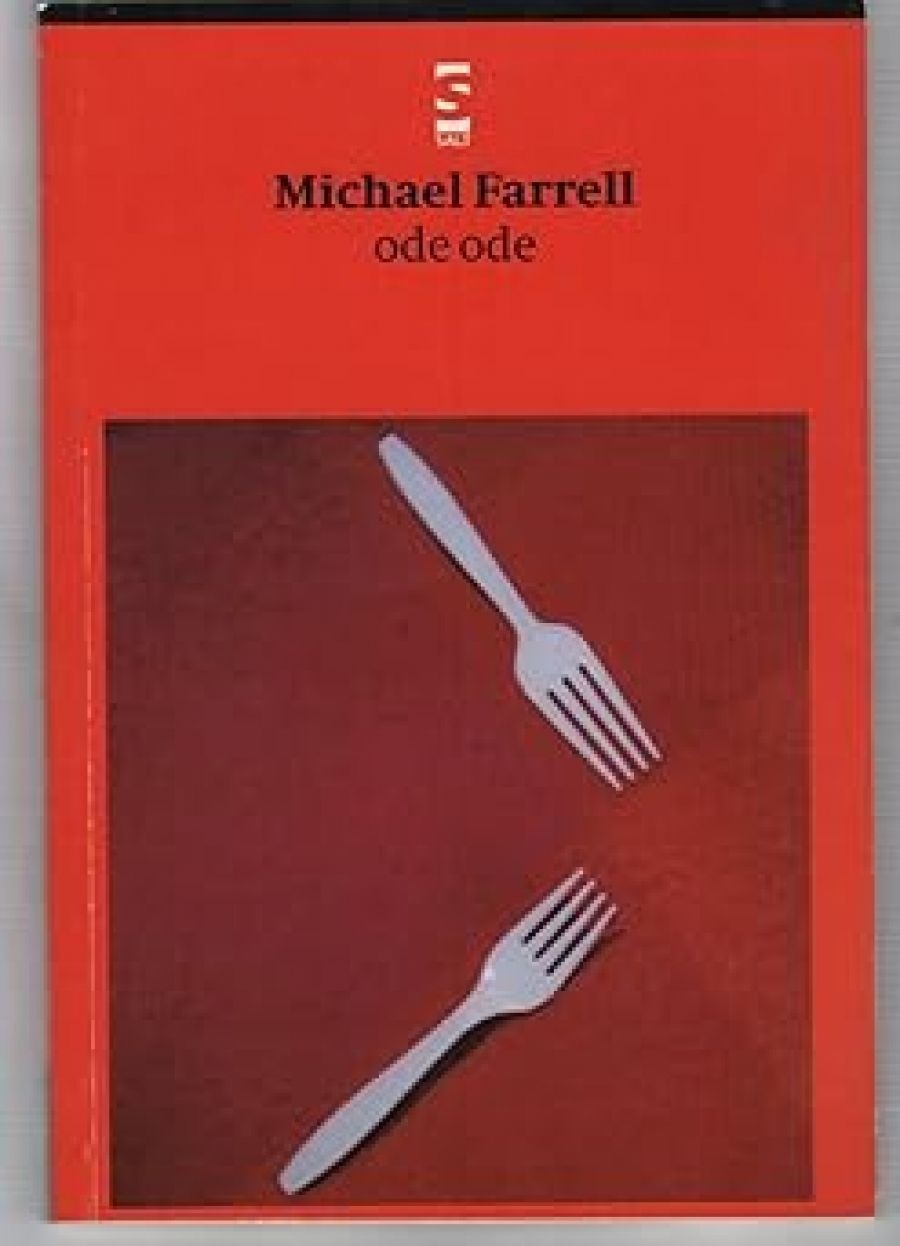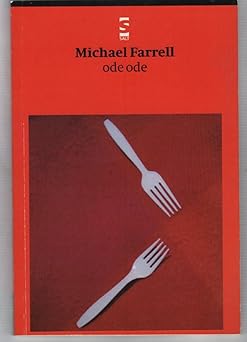
- Free Article: No
- Contents Category: Poetry
- Review Article: Yes
- Article Title: An Arabesque Yes
- Online Only: No
- Custom Highlight Text:
It’s easy to see why Michael Farrell already has something of a reputation as a stylist, though this is his first collection. Inventive, sharp-witted, entertaining and meticulously made, the poems in ode ode offer a lower-case, unpunctuated take on style (‘i perforce have metamorphosed / more than once for a ball at short / notice’) in which style is energised, orchestrated substance.
The untitled, undated first section of the book, consisting of a series of poems called ‘codas’, begins with the explanation that ‘this is cinema made by people / shuffling in gumboots’. Cinema is wonderfully evoked here in poems that are themselves fast-moving, flickering montages, in which ‘time doesnt / just move forward not even the / past’. Scenes and characters, perhaps from films the poet is watching ‘in the mainstream in the arthouse’, slide into one another (‘the boys ugliness becomes / magnificent his screwy behaviour / erases alan bates from the mind’), or cut suddenly to others. Spliced-up scenery and partial sentences are rudely interrupted by utterance-fragments, lines get broken mid-word (‘julia ro / berts robot’), the sense and syntax take a turn for the unpredictable, and we start bumping into cinema’s roles ‘off / screen’ – as public outing (‘just stop me at the festival / a couple of fingers on my / wrist the word drink with a / rising tone’), private world (‘more red more / white i yell from my closeup’), social production (‘a collective / cry from all our hearts’), or confidence trick (‘per / haps his last laugh on holly / wood hmmm what do you think’). But ‘cinema’ is also a metaphor (‘reels / lives its all any of us have’) whose star if you like, or anti-hero, is the lower-case, dotted but unpunctuated first person: ‘this is a movie of the day i was / born the horses are actors all.’
- Book 1 Title: ode ode
- Book 1 Biblio: Salt, $19.95 pb, 102pp
- Book 1 Cover Small (400 x 600):

- Book 1 Cover (800 x 1200):

Part media event, part figure of speech, part cognitive machinery, ‘i’ expresses the faith in ‘codas’ that ‘lifes fragments’ ‘quote me’ (‘how could we hope otherwise / overall a festival of joy then’). This faith is enacted literally in the second section of ode ode (‘97–98’), comprising ‘living at the z’, a series of collage poems haunted by the premonition that ‘one / day the little man will take / our souls into custody i / wish that we could stop this / but think it would stop us’. ‘vidcore’, for example, with its themes of separation and splitting (‘we separated at the store / i at least was literate you / werent that sick’), tells us that ‘i’, having ‘quietly / looked for pure hell’, ‘also found hurting words’ – in Tammy Wynette’s ‘d-i-v-o-r-c-e’, according to the poem’s footnote – ‘& held / them saying i love you both’. At ‘the z’, everything divides and disperses, but the results are not random or chaotic. The borrowings – from Charles Darwin, Marianne Moore, Guns ‘n’ Roses and others – are set in a smaller point size, which adds visual heterogeneity and depth, but also creates a multi-tracking, multilayering effect that Farrell, with great musical dexterity and a wicked approach to tone and phrasing, uses to render an ‘i’ that is multivocal, multiphasic and interactive (‘our need for control / lessens as our ear grows’). Chance and automation (i.e. means of letting the outside in) have left their mark on poems such as ‘extension 34’, where permutations, puns and anagrams contribute to a personal remix of Yoko Ono’s ‘Extension 33’ that, although part homage, is also an example of ‘i’ in action – as parasite and appropriator (‘nits nits scold me break it off’), but also host (‘after i was nailed’) to a globalised (mis)communications network, ‘a crazy conversation’, ‘cassa io’.
The third and longest section of the book (‘96–00’), a miscellany, begins in quite a different style: ‘person with a flute’ is a sinuous, fluid, syntactically supple meditation on ‘interpretation’ that remains focused on its protagonist, ‘you’, whilst ‘wombling free to the tune’ it plays on themes like coincidence, in which ‘there are other musics’. There are many other styles, ‘other musics’, in this section, and also a fair bit of dancing (‘in dances house everything dances’) – to the hare-brained narrative of ‘hare encounter’ (‘we waltzed in a / manner of speaking around a certain subject’), to the halting, pared-down rendition, in ‘pretty pennies’, of ‘the kind of place / mar / married people took off their shoes’, to the triumphant, maniacal ode on extravagance, ‘bird in position’ (‘my knees arent much but in / mes the spirit of the young travolta’). There are poems that waltz (or otherwise dance) around relationships and the rituals of courting, about urban and rural life, about ‘school’ (‘pre / pare him truly in the dis / appointment way which is / to the right’), about art (‘this thorough / fare this trembling nothing / im doing’) and, flickering on and off throughout, the continuing exploits of ‘i’ (‘i was born ok & raised there / im moving further away’).
The last section (‘96–97’) consists of six earlier poems, including at least three gems (‘nude descending a liftshaft’, ‘proust aboard a doomed corvette’, ‘warm ride’) in which themes such as ‘nothing’ (‘there are many emptinesses’) and the ‘nude’ appear – preoccupations that have proved recurrent (‘believings moving your hand knowing / theres no other side it screens nothing’) (‘none of us are / naked’, ‘all / are naked none are safe’). Tracking their development makes for fascinating reading. As for the book’s styles, well, ‘actually i made my own atlas & son / the figure was an arabesque yes’.


Comments powered by CComment